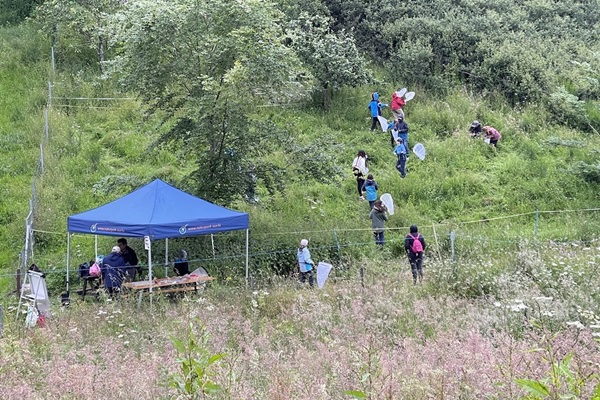 MNHN Biodiversity Weekend;
Credit: Musée national d'histoire naturelle Luxembourg
MNHN Biodiversity Weekend;
Credit: Musée national d'histoire naturelle Luxembourg
Luxembourg's National Museum of Natural History held a Biodiversity Weekend from Friday 14 to Sunday 16 June in Goesdorf (near Wiltz).
Such a concept has been organised for the past 25 years by the National Museum of Natural History, which throws a spotlight on the event dedicated to raising awareness and the importance of preserving the environment, a strong commitment to improving awareness of living diversity in Luxembourg and the general protection of nature.
In 2004, the Biodiversity Weekend took place in the municipality of Lac de la Haute Sûre. 20 years later, it was time to return to the Haute-Sûre Nature Park region. The 2024 event was organised in collaboration with the Öewersauer Nature Park and the municipality of Goesdorf.
On Friday, an educational route with six stations was organised for pupils from the school in Dahl, led by the museum's scientific enthusiasts, consisting of different sections of the Museum and the Haute-Sûre nature park. The students were able to explore the local biodiversity and appreciate its beauty while learning more about nature. This unique and memorable experience enabled them to develop an increased awareness of the environment and to work towards protecting themselves in the future.
On Saturday, the museum announced the "coup de voyage" of the Biodiversity Weekend with a day entirely dedicated to scientific researchers. This day was the opportunity for museum researchers and scientific collaborators to come together to create a fauna and floristry inventory of the municipality of Goesdorf.
On Sunday, the museum organised a discovery walk in Goesdorf, in collaboration with the Öewersauer Nature Park. This walk, open to the public, allowed participants to discover the wealth of local biodiversity in the company of scientific specialists. Thanks to the participation of 103 identifiers and 21 observers, a total of 1,345 observations representing 536 different species have been recorded and verified by the museum's experts, currently on display on the iNaturalist platform (https://www.inaturalist.org/projects/biodiversiteits-weekend-2024-goesdorf)
Plants: 263 species, insects: 173 species, mushrooms: 31 species, arachnids: 23 species, birds: 21 species, mollusks: 15 species, mammals: 4 species.
This does not yet represent all of the diversity examined, since in many groups the precise determination of observations by experts still takes a certain amount of time.
Here are some observations, constituting a small collection of many remarkable species that were reviewed during this weekend dedicated to the diversity of life.
The cute troglodyte (Troglodytes troglodytes; Eurasian Wren) is a small common bird in Europe. It is known for its song and his habit of frequenting forests. Its presence in Goesdorf testifies to the quality of the natural habitats.
The Purple Digitalis (Digitalis purpurea) is a living plant in wooded areas and prairies. Its flowers are in the shape of purple cloche hats. Its presence in Goesdorf is a sign of the abundance of flowers.
The noble oedemera (Oedemera nobilis) is a rare and threatened coleopteran. It is recognizable by its stretched body and its long and thin antennae. Its presence is an indicator of the good health of the region's forestry ecosystems.








